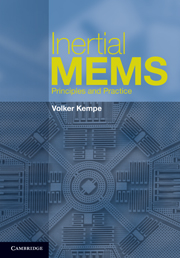Concluding remarks
Published online by Cambridge University Press: 03 May 2011
Summary
MEMS accelerometers and gyroscopes exploit a wide variety of means for excitation and sensing. Actuation is performed by electrostatic, electromagnetic (e.g. using a magnetic z-gyro; see Maenaka et al. [2005]), piezoelectric, and thermal actuation effects. For sensing electrostatic, electromotive-force, piezoresistive, piezoelectric, and thermal effects are used. The excitation may be linear or angular. It may be in-plane or out-of-plane as well as about an in-plane or an out-of-plane axis. Skewed excitation of gyroscopes using the anisotropy of bulk silicon also has been demonstrated [Andersson et al. 1999]. The integration of coherent optical sources, resonators, and photo-detectors into MEMS opens the way for optical acceleration sensing.
It is not just rigid-body systems that can serve as a base for inertial sensors. Any velocity field in gases or fluids is disturbed by the Coriolis effect which creates orthogonal forces on the moving particles. 2D and 3D micro-fluidic or convective gas gyroscopes can be built (e.g. Zhou et al. [2005] and Dau et al. [2008]), exploiting, for instance, velocity-dependent thermal transport processes.
There is still a broad field for innovations within the area of inertial MEMS. However, the future of inertial MEMS will depend mainly on new and expanding applications. Inertial MEMS are increasingly merging with higher-level measurement systems such as GPS for navigation purposes. They are becoming basic components of complex user interfaces, as, for instance, in games and smartphones. They are merging with other sensors such as magnetosensors, ultrasonic and optical sensors etc.
- Type
- Chapter
- Information
- Inertial MEMSPrinciples and Practice, pp. 466 - 467Publisher: Cambridge University PressPrint publication year: 2011



